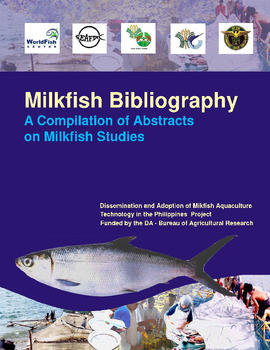| dc.identifier.citation | Dumada-ug, E. B., & Sevilleja, R. (2007). Evaluation of fertilizer use and milkfish yields in Palawan. In T. U. Bagarinao (Ed.), Research Output of the Fisheries Sector Program (Vol. 2. Reports on Fisheries and Aquaculture, pp. 138-149). Quezon City, Philippines: Bureau of Agricultural Research, Department of Agriculture. | en |
| dc.description.abstract | Milkfish yields in Palawan in 1993–94 were low, only 595 kg/ha-yr on average and ranged 100–700 kg/ha-yr in 35 of 50 farms surveyed. Only seven farms had yields between 1,000 and 1,800 kg/ha-yr. Yields were higher in deeper ponds, and shallowness of ponds was a major constraint to high yields. Farm -gate prices of milkfish ranged from P25 to P55 and averaged P42. The prices of milkfish were on average 43x greater than the price of organic fertilizers (chicken manure) and 6x more than the price of inorganic fertilizers. The income from milkfish made up 10-95% and averaged 53% of the total income of the farmers. One crop cycle a year was the practice in 28 of the 50 farms; 20 farms had two crops, and two farms went for 3–4 crops a year. A crop cycle was 3–4 months long in 14 farms, 5–6 months in 29 farms, and 7–9 months in 7 farms. Crop cycles started with draining and drying the ponds and applying fertilizers to grow natural food. Most of the farms were supplied by tidal water and water exchange in the ponds was done every spring tide in 33 farms. The other farms changed water once a month, once or twice in a crop cycle, or once a year. Application rates of organic fertilizers were mostly less than 1 ton/ha-yr and averaged 515 kg/hayr, but three farms used as much as 1,250 kg/ha-yr, and one farm used 3,000 kg/ha-yr. Half as much inorganic fertilizers were used; the average for the 50 farms was only 211 kg/ha-yr, but one farm used as much as 1,350 kg/ha-yr. The fertilizers encouraged natural food to grow in the ponds. Two of the farms grew mostly plankton, 15 grew the benthic mat lablab, and 33 grew the green filamentous algae lumut. None of the farms used commercial feeds. Stocking rates varied widely among the farms, ranged from 1,000 to 60,000 fry or fingerlings per hectare per year and averaged 8,000/ ha-yr. Two-thirds of the farms stocked less than 7,000/ha-yr, but eight farms stocked fry or fingerlings at much higher rates of 13,000–60,000/ ha-yr. An input use variation model showed that milkfish yield was a function of the ratios of prices of milkfish to prices of organic and inorganic fertilizers; pond water depth and salinity; milkfish income as percent of total income; family size; membership in aquaculture association; and contacts with government‘s extension services and information dissemination system. The surveyed farms ranged from 3 to 40 years old, with 92% under 20 years; they had been in operation 1–23 years, 76% of them for less than eight years. Of the 50 farms in the survey, only nine were private (titled) lands, 34 were covered by fishpond lease agreements (FLA issued by the Bureau of Fisheries and Aquatic Resources), and the others had only survey documents or no papers at all. Farm sizes ranged 0.8–50 ha (average 12.5 ha), and 52% of them were smaller than 6 ha. The private farms were small, only 1–7 ha except one that was 25 ha. The FLA farms were much larger, and 23 of them were 5–50 ha. Large parts of the large farms were not operational, and 90% of the farms used effective areas of less than 7 ha. The low lease fees for FLAs evidently did not encourage farm development to increase yields. The farms had mostly shallow ponds 25–100 cm deep (average 68 cm). | en |



